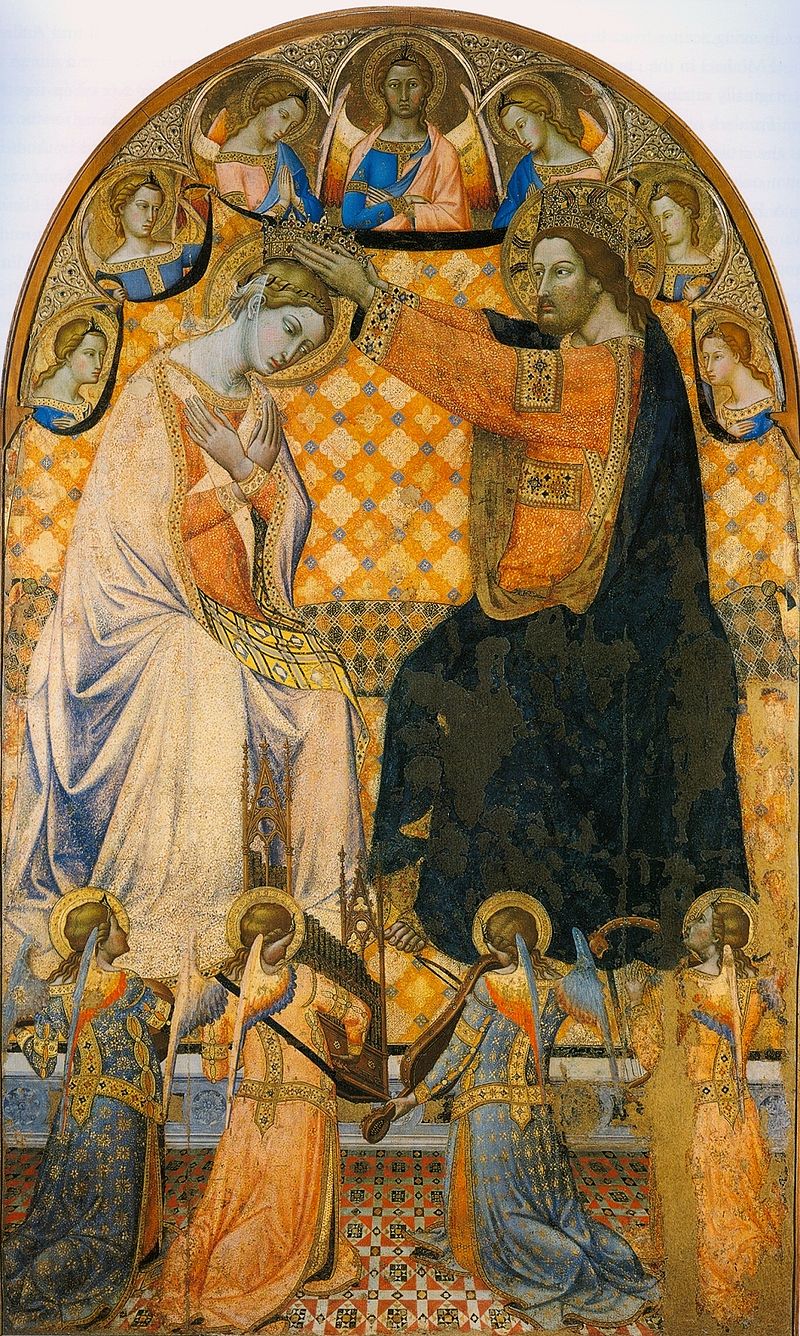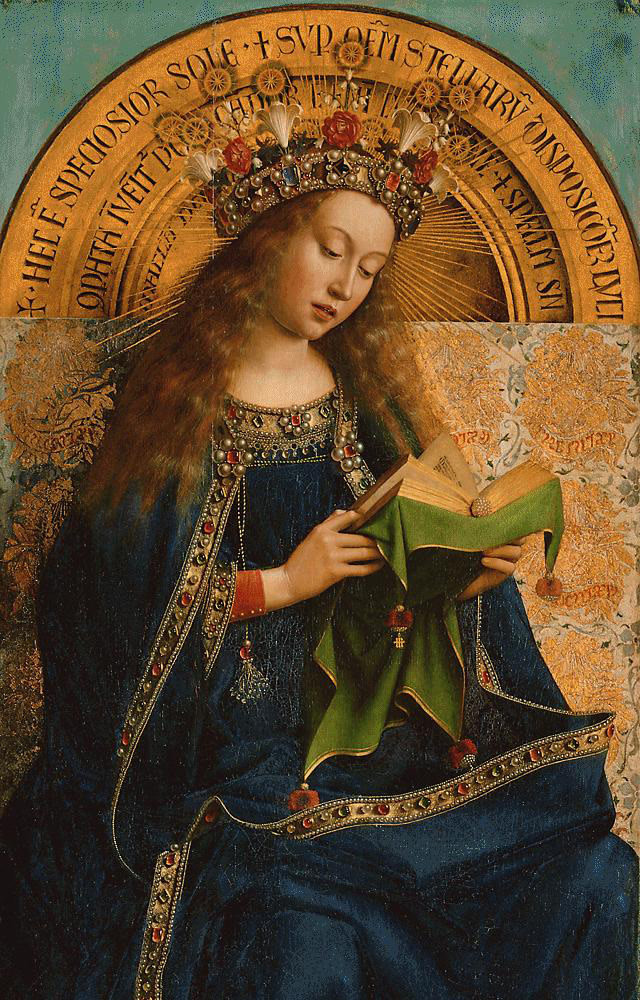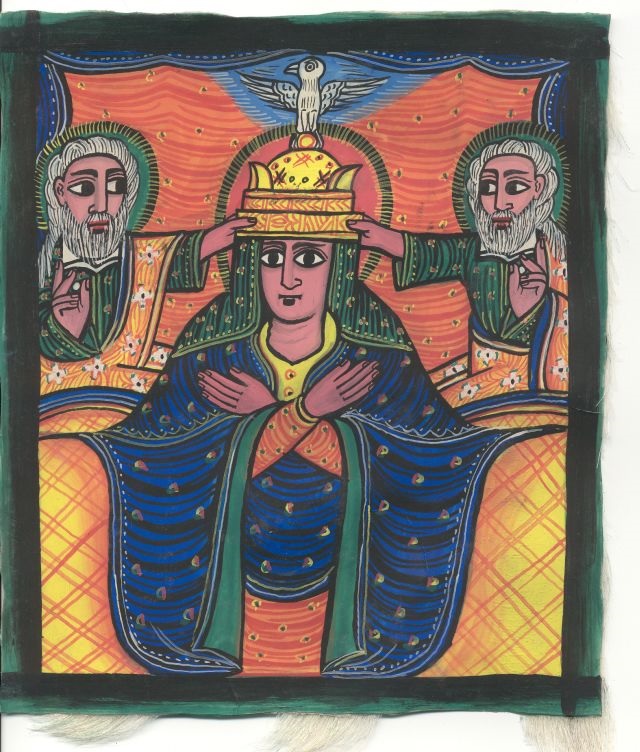Regina coeli, laetare, alleluia:
Quia quem meruisti portare, alleluia,
Resurrexit, sicut dixit, alleluia,
Ora pro nobis Deum, alleluia.
Gaude et laetare, Virgo Maria, alleluia.
Quia surrexit Dominus vere, alleluia.
Queen of Heaven, rejoice, alleluia.
For he whom you merited to bear, alleluia,
Has risen, as he said, alleluia.
Pray for us to God, alleluia.
Rejoice and be glad, Virgin Mary, alleluiah.
For the Lord has truly risen, alleluia.
So far as I know, however, this epithet is not one of the ancient epithets of Mary, whether in the New Testament, nor in the early Church councils, where Mary was referred to as theotokos (the bearer of God, i.e., the mother of God).[2]
The origin of the epithet “queen of heaven” may derive from a phrase in Jeremiah. However, as we shall see, the exact term used by Jeremiah is unclear, and whatever the precise term may have been, it was understood diversely in ancient versions, both Jewish and Christian. Ironically, however Jeremiah’s term is to be vocalized and read, his reference clearly is to the idolatrous and polytheistic practices prevalent in his day.
The term is found in Jeremiah 7:18, and again four more times in chapter 44 (verses 17, 18, 19, 25). The consonantal Masoretic text in each case reads למלכת השמים, but the Masoretic vocalization consistently has לִמְלֶֶ ֶכֶת with a Masoreic annotation that there is (or may be) a missing aleph, in other words that the word should be read as לִמְלֶֶֶֶ ֶאכֶת. The unvocalized text could easily, therefore, be read as le-malkat ha-shamayim (“to the queen of heaven”), whereas the vocalized text, especially if the (possibly) dropped aleph is restored and inserted, could be read as li-melekhet ha-shamayim (“to the work of heaven”).
The scholarly literature is inconclusive regarding which goddess may have been worshipped as “queen of heaven” by Jeremiah’s Judean contemporaries in Judea itself and in Egyptian exile, and the focus tends towards the Mesopotamian goddess Ishtar or the Canaanites goddess Ashtoreth (Astarte) or `Anat. Regardless of which goddess may have been the object of this worship as “queen of heaven,” the detailed reference in 7:18 seems to have involved private, family worship, and Jeremiah specifically refers to children gathering wood, men lighting fires, and women who prepared some kind of cakes (כַּוָּנִים – kavanim) and libations to “other gods in order to anger” God.[3]
The historical questions of Jeremiah’s possible reference to a cult in his day of “the queen of heaven” and which goddess (or goddesses) may have been the focus of such a cult, are beyond the scope of this study, as is the question of whether some early Christians may have been exposed to remnants of pagan worship of “the queen of heaven” in the Greco-Roman world. As mentioned previously, the phrase does not seem to have been applied to Mary in the first Christian centuries (although one cannot deduce much from an argumentum ex silentio).
Our interest is how Jeremiah’s phrase was understood in ancient versions and medieval exegesis, and, in turn, how that phrase, when understood as “queen of heaven,” may have come later to be applied to Mary.
The Aramaic Targum (translation) of Jonathan ben Uziel (a student of Hillel the Elder) consistently renders the phrase שמיא
לכוכבת (“to the star of heaven”), which in turn led traditional Jewish exegetes to understand Jeremiah as referring to the stars as the “work of heaven” or, alternately, if a royal inference is to be retained, to the sun as the greatest (i.e., king) of the stars. Thus Rashi (Rabbi Solomon ben Isaac, 1040-1105) comments on 7:18 that the reference is to “the great star which they called the queen of heaven, in royal language, and thus Targum Jonathan has ‘the star of heaven’.” Radak (Rabbi David Kimhi, 1160-1235) notes that “it lacks the aleph, and it means ‘like the work of heaven,’ i.e., the stars.” And on 44:17, Radak comments: “It means the work (ma`aseh) of heaven, namely the stars which are the work (melekhet) of God. It is missing the aleph . . . Some interpret it as le-malkat, from the root melekh (king), meaning the great star in heaven which is the king of the other [stars], namely the sun, as Jonathan [ben Uziel] translated it ‘to the star of heaven’.”
The Septuagint translated 7:18 as te stratia, which would be the equivalent of the common Hebrew term צבא (army, host), as in “the Lord of hosts,” a phrase usually understood to mean the stars which are God’s “army.” However, in chapter 44, the Septuagint all four times renders the epithet Basilisse tou ouranou, queen of heaven.[4]
The Latin Vulgate consistently renders the phrase as reginae coeli, not only in chapter 44 but also in chapter 7 (where the Septuagint, as noted, has stratia, not Basilisse). On the other hand, in Jerome’s incomplete commentary to Jeremiah (which extends only to chapter 31), he seems to have consulted both the Hebrew text (which he understood as “queen”) and the Septuagint’s te stratia, and both his translation and his commentary reflect his uncertainty regarding the meaning of the phrase in 7:18.[5] Jerome’s translation in the commentary refers to both possibilities, that the women made cakes for the queen (“reginae”) or the army/host (“militia”) of heaven:
. . . ut faciant placentas (sive: chavonas) reginae (sive: militia) coeli . . .
. . . to make cakes – or “chavonas” – for the queen – or host – of heaven . . .[6]
Jerome’s commentary then also offers both interpretations:
. . . ut faciant CHAUONIM (כוונים)[7] quas nos placentas interpretati sumus, sive praeparationes, ut omne genus ostendat sacrificii reginae coeli, quam lunam debemus accipere; vel certe militiae coeli, ut omnes stellas intelligamus.
. . . in order to make CHAUONIM (כוונים), which we have translated as “cakes,” or as “preparations,” which refer to every kind of sacrifice to the queen of heaven, which we should take as “the moon;” or for sure to “the host of heaven,” which we would understand as all the stars.
Conversely, the Syriac Peshitta in 7:18, 44:17, 44:18, and 44:25 has לפולחן שמיא (to the work of heaven; or: to the service of heaven), but in 44:19 has למלכת שמיא (to the queen of heaven).
In opposition to the suggestion that Jeremiah’s phrase provided the origin of the epithet regina coeli as applied to Mary, one could, of course, refer back to the New Testament itself as the source:
And a great portent (semeion; sign) appeared in heaven, a woman (gyne) clothed with the sun, with the moon under her feet, and on her head a crown (stephanos)[8] of twelve stars. She was with child, and she cried out in her pangs of birth, in anguish for delivery. (Revelation [Apocalypse] of John 12:1-2; RSV)
The Greek text never explicitly refers to this “woman” as “queen” (basilisse), although it does say that she had a wreath or crown (stephanos);[9] nor does the Vulgate refer to her regina:
Et signum magnum apparuit in caelo: Mulier amicta sole et luna sub pedibus eius, et in capite eius corona stellarum duodecim ; et in utero habens clamabat parturiens et cruciabatur ut pariat.
What is particularly significant here is that the Vulgate – which, as we have seen, consistently translated all the passages in Jeremiah as reginae coeli – does not use this phrase here, however suggestive the passage may have been to later Christians. Nor does the passage in the Revelation [Apocalypse] of John identify the woman with a crown on her head as Mary. One cannot construct a proof ex silentio, but a series of associations may provide the connection in the minds of later – and perhaps even earlier – Christians. Jeremiah’s “queen of heaven” (which is, as we have seen, one way to read the text) may have been the link between the undefined and unnamed “woman” (gyne; mulier) in heaven with a “crown” (stephanos; corona) on her head in the Revelation [Apocalypse] of John, with Mary as regina coeli.
To reiterate: the text of Revelation 12:1-2, even in the Vulgate, makes no such explicit terminological association. However, a conceptual association that may have been obvious to later Christians, may not necessarily have been obvious to the early Christians, who used other terms for Mary, but not (at least not in the New Testament or early council documents) the term regina coeli. On the other hand, perhaps we should differentiate the explicit term from the implicit concept: a concept, however embryonic, may have existed among early Christians, even if it only became terminologically explicit in later ages.[10]
A different association for the woman with a crown of stars, clothed with the sun and with the moon at her feet in this New Testament passage could be with the theme of the “Queen Mother,” a powerful figure in the Book of Kings, where various kings are mentioned as having ruled for a number of years, and then “the name of his mother (ושם אמו) was X.”[11] However, once again we have here at best only a possible conceptual association, but not a terminological one, and even then, the association would be with the “queen mother” in Kings and not the “queen of heaven” (if that is the correct reading) in Jeremiah.
In summary, the passage in Jeremiah is thoroughly obscure. We do not know which goddess was the object of the idolatrous worship. We – like Jerome and the Targum – do not know what the כַּוָּנִים (kavanim) were, that the women made of dough in honor of the goddess. We also do not know how to punctuate – and thus how to understand – השמים למלכת, and whether (if read as malkat ha-shamayim) it refers to the queen of heaven, or whether (if read as melekhet ha-shamayim), it refers to “the work of heaven,” presumably the stars as God’s heavenly hosts.
In conclusion, the Masoretic text of Jeremiah’s reference to idolatrous and polytheistic practices in his day, and the ancient versions, both Jewish and Christian, are thus unclear and inconsistent as to the precise way
השמים למלכת is to be read and understood. However, a Jewish text – the Septuagint – as well as the Peshitta,[12] gave at least some, if not consistent, support for a Christian text – the Vulgate, which became the authorized Bible of the Roman Catholic Church – to render it consistently as “the queen of heaven.” In turn, the Vulgate passage may have been the origin or inspiration for the medieval tradition of Mary as “queen of heaven.” This tradition, in turn, gave rise to – and is reflected in – Christian art, in which Mary is depicted as the crowned queen of heaven.
 |  |
Sanctae Mariae Coronavi by Giacomo di Mino's Gothic version. Circa 1340–1350 | Virgin Mary, detail from the Ghent Altarpiece (St. Bavo’s Cathedral, Ghent, Belgium) by Hubert and Jan van Eyck, 1432. |
 | |
17th century Ethiopian icon depicting Mary being crowned by God the Father and by Jesus (God the Son) with the dove (the Holy Spirit) above the crown. |

